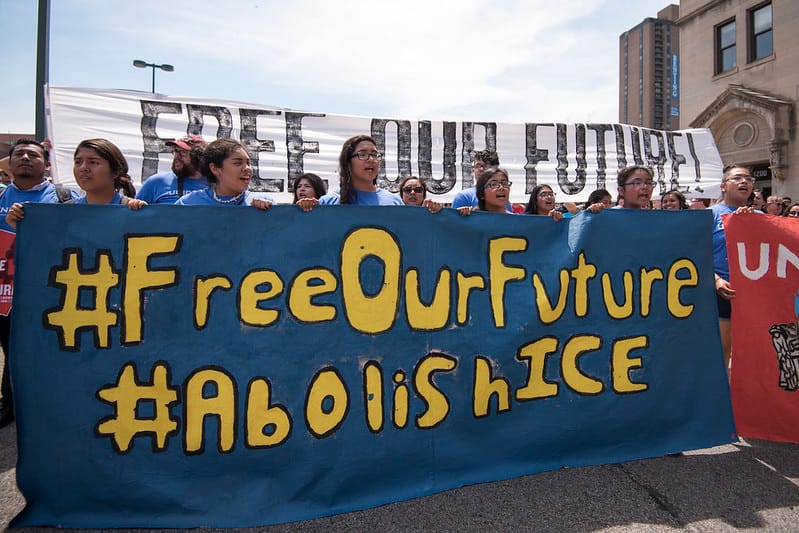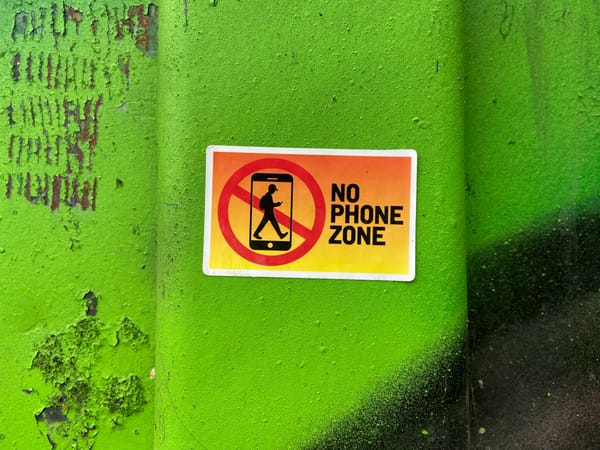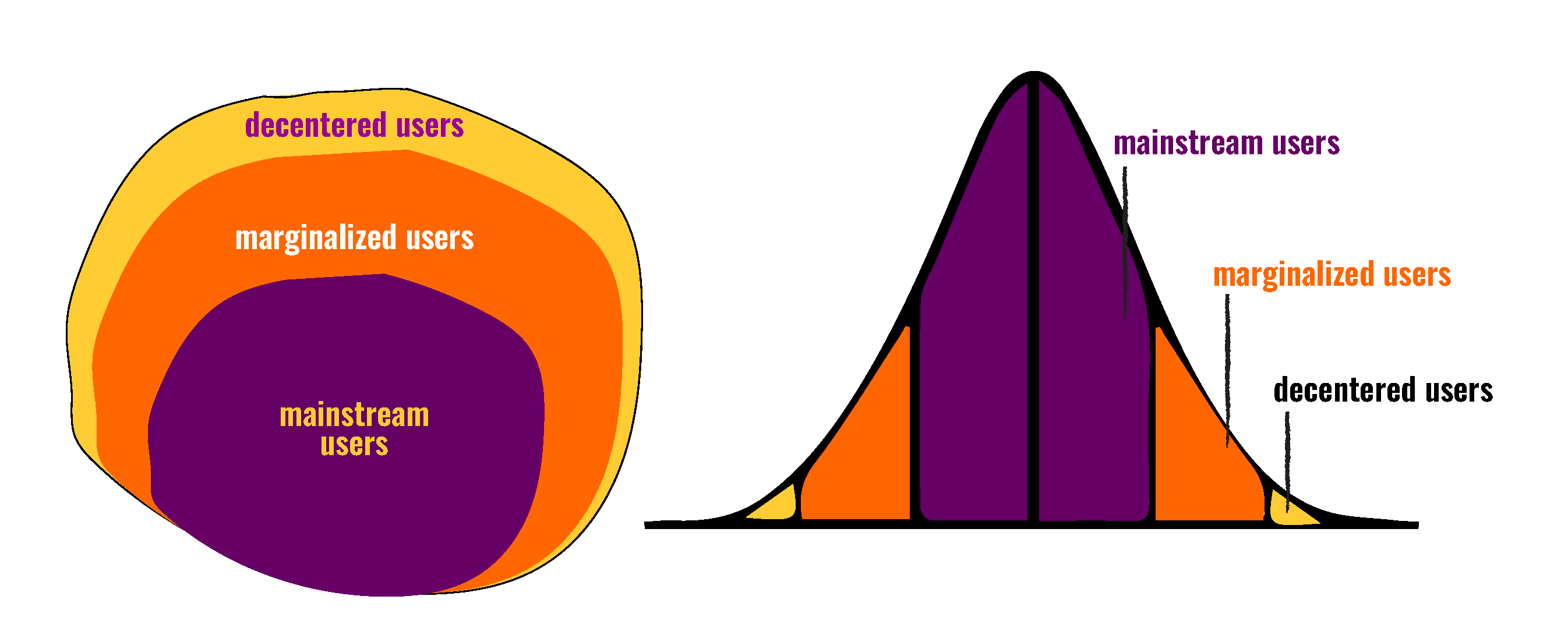Dehumanized by Design: Autocratic Tech and Immigration
Understanding a regime’s mechanics – like repression of speech on Palestine movements and migrants’ rights – is key. These times call for movement technologists to know how criminalization actually works, including the low-tech tactics, writes Afsaneh Rigot.

Within its first 100 days, the Trump administration has already made high-profile, politicized arrests of migrants – many have been deported or held in immigration detention, where conditions are dire. Palestinian and pro-Palestine students have been framed as “terrorists” or “terrorist sympathizers” and Latin American migrants – particularly Venezuelans – labeled as violent gang members. This spectacle of cruelty is clearly strategic and interlinked. It allows the administration to use those historically demonized by power as entry points to broader authoritarian control. The abuse of these specific groups, these targets, has already been mainstreamed and normalized. And while it is not the first time for either of these groups, it is intensifying.
In order to criminalize groups of people, simply writing a law is not enough. A culture and social mindset must first be cultivated. There is a long history – in the U.S. and globally – in which certain communities have been dehumanized by design in order to enable and legitimize expanded systems of control.
U.S. Immigration and Customs Enforcement and the Department of Homeland Security have been at the forefront of this theater. DHS’ abduction of Mahmoud Khalil, a Palestinian graduate student, in his apartment building as his wife watched, shocked people worldwide. From there, there has been a steady drip of chilling videos, including one of masked agents swarming Rumeysa Ozturk, a doctoral student who penned an op-ed. Many students have been targeted and arrested based on little-to-no evidence except pro-Palestine speech, all while the US kept the genocide funded, and the administration high-fived, vowing more to come.
At the same time, the administration forcibly – and very publicly – removed more than 250 predominantly Venezuelan migrants from their families in the U.S. to El Salvador’s notorious Terrorism Confinement Center (CECOT) mega-prison. There was no due process and no clear exit out of the prison. The deportation was sadistically posted and heavily televised – images reminiscent of concentration camps rotated. Detainees were labeled as "violent" gang members of Tren de Aragua, based solely on their nationality and physical markers such as irrelevant tattoos or photos on their phones. The number of those being ensnared is rising.
This dual repression feeds into a populist-fascist playbook to form a feedback loop: dehumanize, criminalize, repress, expand, repeat. The bipartisan groundwork has been laid through years of various tactics. We have watched as borders have been militarized, surveillance maximized, and protest curtailed, to name but a few. America has never been a free or true democracy for many of the most marginalized communities. They have long experienced the warning signs of systemic gaps that allowed a demagogue to rise and these fascist tactics to take root. Now, there is a greenlight for the expansion of criminalization and control.
Unfortunately, this administration will continue to arbitrarily devastate lives until they are stopped. While major institutions have been conceding to the authoritarian and mob-like shakedowns, communities have still come together. There are examples of people protesting these actions on the streets and in the courts, with lawyering and their wallets. There are communities with decades of experience in resistance in this country and around the world who know exactly what is needed.
Repressive regimes often mimic each other, which makes pattern recognition necessary. Connecting these dots is therefore vital in how we do harm reduction in tech, as well as our resistance on the streets. We have the tools and know-how to challenge and outsmart some of the tactics, like many have done globally. Understanding a regime’s mechanics, especially from those who endure its enforcement, is key.
It’s Not New, It’s Turbo-Boosted
ICE has been violent, with the support of Republican and Democratic administrations, for decades. The money and resources invested in tracing migrants has led to the vast expansion of militarized walls, drones, detention, and surveillance. The undocumented have long been brutally snatched from their homes, streets, schools, and workplaces. ICE has a history of raids and removals based on racial profiling, with little to no evidence, like “Operation Return to Sender” in 2006, when people were clearly taken based on their race simply because agents had quotas to fill. And while many first started to hear of Guantanamo after 9/11, “extraterritorial migrant detention” to the US military base has been used for Haitians and Cubans since 1991. Through the years, the conditions in migration detention have become increasingly awful.

That said, the March 2025 abduction of Venezuelan men severely raised the bar: migrants were vanished into a foreign system with no due process; no real route for return or release. A new pipeline to outsource to El Salvador’s Bukele regime, which has detained 75,000 since 2022 under a brutal “war on gangs,” emerged. The prison is known for arbitrary detention, torture, and other forms of inhumane treatment.
Khalil’s case also marks a shift in its speed and in the fact that he is a green card holder with no criminal record. Regardless of the outcome, the abuse Khalil endured has now been cemented as a possibility. The Trump administration brazenly confirmed that he was detained due to his pro-Palestinian activism during the Gaza solidarity encampments at Columbia University. The Biden era primed the pump with intense crackdowns, defying international law and courts, tagging pro-Palestine and anti-genocide protests as national security threats (see Jewish Voice for Peace’s statistics on the first student encampment protests in the U.S.). This tactic has been used globally with the “Palestine Exception.” Furthermore, the groundwork has been laid since the inception of the War on Terror and the Islamophobia that it baked into the American psyche.
Now here we are, witnessing the administration aggressively shifting the Overton Window, broadening criminalization and penalties. And it is all under the guise of national security in order to unleash an arsenal of repressive measures, old and new. ("Protecting the American People Against Invasion," for example, was very much on the nose.)
Khalil’s case is also allowing them to invoke a rarely-used provision of the Immigration and Nationality Act (INA) to revoke his green card. The INA enabled mass deportations like "Operation Wetback" in 1954, which expelled over one million Mexican immigrants under brutal conditions. Many of them were U.S.-born. Its vague, "subversive" provisions also fueled McCarthy-era “Red Scare” purges, targeting and deporting thousands of labor leaders and leftist activists for political beliefs with little evidence. Sound familiar?
In the case of the deportation of the Venezuelan men, it was not about proof, but about how their ethnicity fit an image – and creating an “enemy within” atmosphere. The administration’s declaration of a non-existent war while branding the group as a "hybrid criminal state" here to invade the U.S. is partly a strategy to revive the Alien Enemies Act (AEA). The AEA, a relic of 1798, was infamously used to intern over 110,000 Japanese Americans during WWII, one of the darkest times in U.S. history. The idea is to justify mass deportations and increase mass incarceration. (The administration is still threatening the use of the Salvadorian torture prisons, hoping for a Supreme Court win. Either way, they can land on mass incarceration.)
The U.S. has a long history of expanding control through fear, war, and immigration. Laws framed as counterterrorism or national security have been weaponized to silence political opposition and erode civil liberties, with tech industry complicity (see our guardrail advisor, Dia Kayyali’s latest piece for more background and tactics used, from COINTELPRO to the post-9/11 era).
During the rampages of the War on Terror, for example, many of those imprisoned in Guantanamo Bay were imprisoned after simply trying to cross the Afghanistan-Pakistan border. In an interview for our upcoming report on this topic, we spoke at length with Andy Worthington about his investigations into Guantanamo. “People were trying to escape from Afghanistan [...] The requirements from the senior U.S. military command were that every single ‘Arab’ who ended up in U.S. custody, regardless of the circumstances, was sent to Guantanamo. But really the bottom line is they didn't know who they had.” We see the boomerang today.
To be clear, evidence and due process is not what this administration is looking for – only prosecutions and ways to expand repressive tools. Precedents have been set. First, if there is protest or resistance, call it a “national security” threat or an act of terror and use the precedent to curtail rights broadly. Second, criminalize migration to stifle dissent based on a whim. Anything from a minor infringement or bureaucratic error to tattoos and photos on a phone can suffice for detainment and removal – a tactic we have documented in countries across the globe.
It’s Not Always High-Tech
When talking about state repression, we cannot only invest in protection against high-tech mass surveillance systems. Lower-tech tactics – which we define as tech combined with traditional policing – are used to identify and criminalize groups and are still not fully protected against. When it comes to criminalization, street-level searches, border profiling, device checks, and manual social media monitoring are often more insidious and effective.
While billions have been spent on high-tech systems that are very dangerous, enforcement teams often do not know how to fully use them. It is nevertheless a good tool to create the illusion that Big Brother is watching. It’s much cheaper to scare people into self-policing.
In 2017, ICE solicited tech companies to build algorithms for monitoring online content. Since then, they have built a huge arsenal from automated surveillance like LexisNexis or Giant Oak Search Technology (GOST) systems. These systems were deployed to detect “derogatory speech against the US” across platforms. Secretary of State Marco Rubio went as far as to promise an AI-infused “Catch and Revoke” system, which he says will take visas of foreign nationals linked to groups that they see as being “pro-Hamas.”
While these automated surveillance systems cast a wide net and can be immensely dangerous, the scale often drowns in unprocessed data. Agencies often struggle to understand or even know what to do with the information. For example, in a recent Congressional hearing, even former-ICE Chief of Staff Deborah T. Fleischaker (Minority Witness) pushed back on the request for increased surveillance tech and interoperable data-sharing between government agencies – not because of any concern for the abuses of immigration controls. “In my experience, immigration law enforcement already has access to vast amounts of data and technology, and immigration officers have no shortage of potential enforcement targets. What they do not have enough of, however, is the ability to analyze, sort, and prioritize that data to ensure they are focused on the right targets,” she said.
While that is a chilling statement, and one not to be taken lightly, it is an admission that presently they do not have the capacity or skills to target monitoring our every move. Yet.
Their desire for data outweighs their capacity to use it unless they have specific targets. (Once a “target” is identified, they have more means to monitor the person. In the research for our upcoming report, we have seen firsthand the serious expansion and focus on the surveillance of those already incarcerated or e-carcerated.)
Accuracy is not a priority when whole communities are the target, but this lack of ability/resources to process the gathered data is still a major issue. It is even reflected in how private companies advertise to law enforcement (i.e., our tech will help you finally analyze your data with AI!). Everything looks like a threat when you have no idea what you are looking at.
As a result, authorities revert to other, easier tactics that actually cause more risk. In our decade of research from around the world, we have found in case files, and with most of our interviewees, that police and enforcement agencies combine tech with traditional methods. These often outstrip automated systems in effectiveness in criminalization. They provide specific, targeted leads rather than vast, often irrelevant, data sets. In other words, it can be the easiest way to hit a quota or close a case. Another method we saw was opportunistic prosecutions that we see with ICE, which makes it unsafe for those looking to report anything.
Like many other enforcement agencies around the world, instead of automated social media monitoring, ICE manually surveils social media. They look for public online accounts and cross reference the details to identify and arrest people. For example, a Facebook check-in at Home Depot could lead to identifying a person’s location. In some cases, they make fake social media accounts to do “masked monitoring” of individuals. They also rely on community/deputized civilian tips that can lead to arrests or directly trigger detentions (ICE self-reported that it gets 15,000 calls per month on its tip line).
A popular method we have documented through the years is converting civilians into informers. Bukele and many authoritarians around the world are known for using this tactic. We’re seeing this with Betar, a pro-Israel group (previously designated as a terrorist group), providing data and surveillance footage of protestors and lists of people for deportation, including recordings they did themselves. Some experts see these lists as being used to target university students. They then further use the footage to cross-reference “video with a person’s online footprint, building a profile and dossier.” (Importantly, Betar suggests that their facial recognition technology (FRT) can identify protestors. (The nefarious abuses of FRT are vast, but the glitchy demonstration, and the group’s (and Hawila's) history of deceit for clout, makes their claims of a new suspiciously super-powered FRT questionable. They’re likely cross-referencing people more manually.)
Encounters with law enforcement, for example, at airports and ports of entry pose extreme risks for migrants. CBP officers have broad authority to question individuals and conduct warrantless device searches under the “border search exception.” These searches can expose personal contacts, travel history, and asylum claims. A photo can be enough, as we’ve seen in the case of the Venezuelan men or the Lebanese doctor who allegedly had deleted photos linked to designated groups. But as things may expand, hoping search warrants will be a barrier to random device checks may be naive. We need ways to prepare.
Jerce Reyes Barrios, one of the Venezuelan asylum-seekers and a former soccer player removed to El Salvador, was taken not for a crime, but for a crown-and-soccer-ball tattoo and a social media photo flashing a “rock on” gesture. The stories of most of the men echo his. During interviews for our upcoming report, I spoke at length with Rina Montti, an El Salvador human rights expert, who described Bukele’s police method to find “gangs.” It included rifling through phones, looking for three things. “The first one is the photos. If they have photos doing some kind of sign, hand sign of a gang member, or if they have some gang member photo. And the second one is their messages. The chat, the WhatsApp, or Facebook chat, or Instagram chat. And the third one is the music. It’s really, really silly. Because they think that they are some kind of gang music.” In other words, catching whoever fits, filling their quotas.
This echoes findings from our research in MENA, where we documented the targeting of queer people. There, a gender-nonconforming photo or a queer dating app on a phone was enough to convict. Device searches are the go-to tactic of abusive systems, from Kenya’s protest crackdowns, to Palestine, where our interviewees say checkpoint searches (body and device) inflict the most prevalent harm – despite Israel’s advanced surveillance tech, as we’ve documented in our upcoming report.
When more advanced tech is adopted, it is those used in tandem and effectively with more traditional tactics that are vastly more dangerous. For example, the use of systems like Cellebrite for jailbreaking/rooting phones has resulted in increased risks in illegal and abusive device searches that we have documented in many countries around the world. (Though note, even here, law enforcement does not have the resources to analyze their mounds of data extracted in each case).
We Already Have the Tools
We need to ensure that people are aware of the more manual surveillance methods and have tools to navigate them – especially in the coming months or years – whether at protests or borders, immigration appointments or, frankly, anywhere one can come into contact with law enforcement.
As the criminalization of large groups expands, the risks of how our everyday tech can be manipulated in the hands of law enforcement cannot be underestimated. Movement technologists are vital and should understand how criminalization happens – and learn from those experiencing it. They know the practical mechanics. It also means knowing the adversaries’ limitations. And frankly, they can be outsmarted, because we know how they work – as well as their blindspots.
We spend a lot of time concentrating on these methods and investigating how law enforcement works within our communities. We learn their methods and reverse engineer them for people’s safety. And we have seen how these protocols make the difference between sentencing and release in some of the most high-risk contexts.
Through our work with criminalized communities in MENA, we already have recommendations, built with experts like the Guardian Project and Norman Shamas, about how to aid these groups from the tech-side. These types of resources from around the world provide insight into what may come and how to prepare in the U.S. context. In addition, we have more recommendations coming from direct research in the U.S. and globally.
The onus of privacy and safety should not always be on individuals. There is advice for digital and physical safety out there, and the tactics already being used by savvy communities is documented. The hope is that we actually build this knowledge into the tech we create, knowing that we must build tech for people, not power. For example, we need:
- Ways to hide our sensitive data/chats/apps or have a “clean profile” if the device is accessed so as to bypass the initial device search
- Emergency data deletion options that are stealthy if arrested and forced to open a phone
- Devices built so they are resilient against jailbreaking/rooting
- Methods to combat police entrapment and manual social media tracking and surveilling – without requiring privacy intrusive measures
- Anonymity and a move away from phone number registration
The list goes on..
We have put out our draft base-line guide for de-weaponized tech from inception to deployment, so we can fight back in our build. We’ll keep updating and building on them as the enforcement strategies expand.
Final Note

Growing up under and around authoritarianism – and spending years investigating criminalization and having experienced it – I know how the oppressor likes to pretend that it is more powerful than it is. It relies on it. Anyone who has ever been a part of a decentered group and dealt directly with this instinctively understands these tactics. It is important that we do not overstate these powers in our collective imagination. Instead, we can study their mechanics.
As we fight, these cycles must be broken from the first step: humanize those who they dehumanize and villainize as “invaders” or “terrorists.” This means firmly standing with Palestinians' liberation and migrants against oppression. Unless we do that, we will always end up back here. We must then recognize these so-called targets are indeed likely the leaders in how to fight back. Our power lies in the fact that the oppressed always know the oppressor better than it knows itself.
Meet Our Team
Afsaneh Rigot is the Founder and Principal Researcher of the De|Center. She is also an advisor to the Cyberlaw Clinic at Harvard Law School and ARTICLE 19, as well as an affiliate at the Berkman Klein Center at Harvard University. She is the author of the Design From the Margins methodology and a number of landmark research projects on tech, human rights, international policing, and state violence.
Jessica Fjeld is the Managing Director of the De|Center. She is also an affiliate of the Berkman Klein Center for Internet & Society, a guest instructor at Harvard Law School’s International Human Rights Clinic, and a member of the boards of the the Data Nutrition Project and the Center for the Study of Technology and Society (CETyS) at Universidad de San Andres.
Roja Heydarpour is a writer and editor for the De|Center. She has worked for The Daily Beast, The New York Times, Al-Monitor, and Columbia Global Reports, among others and teaches ESOL and citizenship preparation classes at the Brooklyn Public Library.
Find our Advisory Board Members and Guardrail Advisors on our site: The De|Center
Also, we’re now on social media! Be some of the first to follow us and share.





